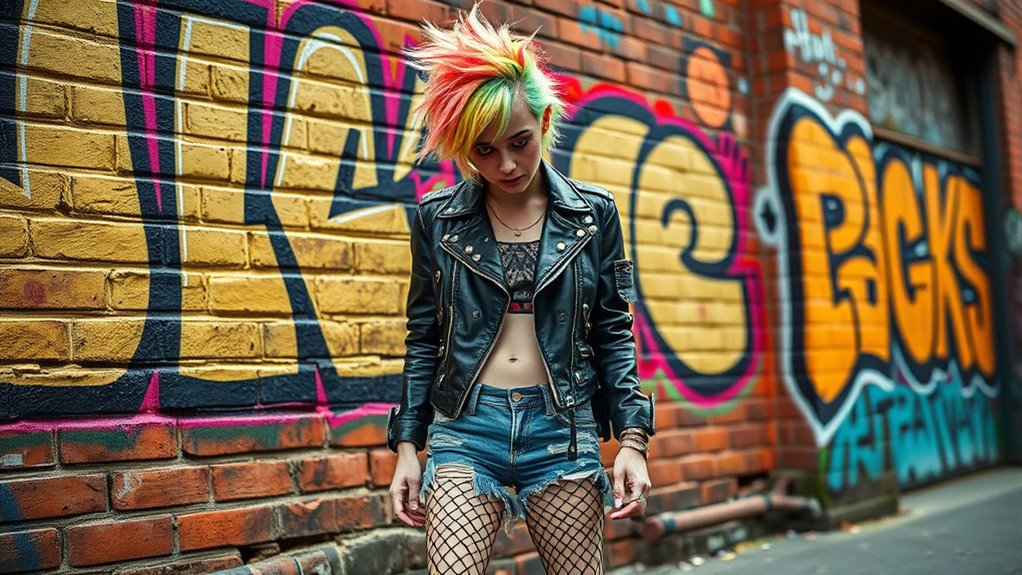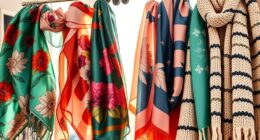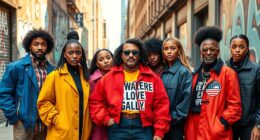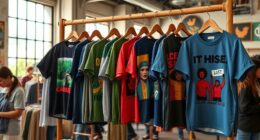Punk fashion started in the 1970s as a bold rebellion against mainstream styles, emphasizing chaos, imperfection, and individuality. You’ll notice it’s built on a strong DIY ethic, where people personalize old clothes with patches, rips, and safety pins. Accessories like spikes and safety pins symbolize defiance. This style promotes self-expression, breaking rules, and making visual statements. Want to discover how this rebellious look shaped culture? Keep exploring to learn more.
Key Takeaways
- Punk fashion originated in the 1970s as a rebellious, anti-establishment movement emphasizing chaos and imperfection over polished styles.
- It is rooted in a strong DIY ethic, encouraging handmade, repurposed clothing, and personal modifications to express individuality.
- Iconic accessories like safety pins, spikes, and patches symbolize defiance and are often handmade or repurposed.
- The style features torn garments, distressed shoes, and clashing patterns, creating a raw, chaotic aesthetic.
- Punk fashion quickly influenced wider youth culture, promoting self-expression, rule-breaking, and nonconformity.

Have you ever wondered how punk fashion became a symbol of rebellion and individuality? It all started with a desire to stand out and reject mainstream norms. Punk fashion is rooted in a strong DIY ethic, which means you don’t need a designer label to make a statement. Instead, you use what you have—old clothes, scrap materials, and your creativity—to craft a look that’s uniquely yours. This approach empowers you to express discontent and defiance through your style, making every piece a personal statement. Punk accessories play a vital role here, adding attitude and edge to your outfit. Think safety pins, spiked bracelets, studded belts, and patches sewn onto jackets. These accessories aren’t just decorative—they’re symbols of rebellion, often repurposed or handmade to show your individuality. Punk fashion encourages you to customize and modify your clothing, turning everyday items into powerful symbols of nonconformity. For example, you might rip and distress a pair of jeans or add graffiti-style patches to a vest, turning ordinary garments into rebellious artifacts.
The punk scene emerged in the 1970s, and its fashion was a direct reflection of its anti-establishment stance. It was about rejecting polished, commercial styles and instead embracing chaos, rawness, and imperfection. You’d find people wearing torn shirts, safety pins holding fabric together, and shoes that look like they’ve seen better days. The punk aesthetic isn’t about perfection but about making a statement through deliberate roughness and DIY modifications. These choices help you project your attitude and showcase your refusal to follow societal expectations. Punk accessories became iconic symbols of this attitude, from metal spikes to chains and buttons with provocative slogans. You didn’t need a lot of money—what mattered was your attitude and your ability to transform ordinary items into symbols of your personal rebellion. Additionally, the use of symbolic accessories became a defining characteristic of punk style, emphasizing both creativity and defiance. This style quickly spread beyond music and into wider youth culture, inspiring countless individuals to craft their own looks and challenge traditional fashion standards. You see it in the way punks mix and match patterns, clash colors, and pile on accessories that scream defiance. Punk fashion isn’t just about clothing; it’s a movement that celebrates self-expression and nonconformity through a rebellious aesthetic. Your ability to create your own punk look—using the DIY ethic and punk accessories—cements your place within this rebellious subculture. It’s a visual declaration: you’re not afraid to stand out, to break rules, and to express your individuality in a loud, unapologetic way.
Frequently Asked Questions
How Did Punk Fashion Influence Mainstream Clothing Trends?
Punk fashion markedly influenced mainstream clothing trends by inspiring streetwear crossover and encouraging bold, rebellious styles. You’ll notice how luxury brands now adopt punk aesthetics—think studs, leather, and distressed looks—blurring lines between high fashion and subculture. This fusion has made punk-inspired clothing more accessible, allowing you to express individuality while embracing edgy, avant-garde styles that originated from punk’s rebellious roots.
What Are Some Iconic Punk Fashion Designers and Brands?
You should know that punk rock fashion was shaped by iconic designers and brands like Vivienne Westwood, known for her rebellious designs with safety pins and ripped fabrics. Malcolm McLaren also played a key role, popularizing the punk aesthetic. These pioneers embraced DIY ethos, inspiring mainstream brands to adopt edgy elements like safety pins, leather jackets, and distressed looks that continue to influence fashion today.
How Has Punk Fashion Evolved Internationally Over the Decades?
You see punk fashion morphing across borders like a riotous mosaic, reflecting local grit and rebellion. Over the decades, it’s embraced cultural adaptations and regional variations, blending traditional motifs with raw edge. In Japan, fierce street styles clash with polished looks; in the UK, gritty DIY ethos persists. This evolution keeps punk vibrant, fiercely adaptable, and ever-changing—each region adding its own rebellious voice to the global chorus.
What Materials and Techniques Are Commonly Used in DIY Punk Fashion?
In DIY punk fashion, you often use materials like studded leather and safety pins to create bold, rebellious looks. You might customize jackets with spikes or patches, attaching safety pins to distressed clothing for an edgy vibe. Techniques include sewing, pinning, and ripping fabrics to add a raw, personalized touch. This hands-on approach lets you express your individuality and punk ethos through unique, crafted pieces.
How Do Punk Fashion Styles Vary Across Different Subcultures?
Like a chameleon changing colors, punk fashion styles differ across subcultures. For instance, hardcore punks often sport leather jackets with ripped details and spiked accessories for a rebellious look. Meanwhile, skate punks might favor baggy pants and band tees, adding patches. Each style expresses unique values and attitudes, with accessories like spikes and studs emphasizing defiance. Your choice of materials and design reflects your specific subcultural identity within the punk universe.
Conclusion
As you embrace punk fashion, remember it’s more than just style—it’s a rebellion echoing the spirit of Icarus daring to defy limits. Your look, like a modern-day mosaic, reflects history’s raw honesty and DIY ethos. By wearing it proudly, you join a lineage of outsiders who refused conformity, carving their own path. In this act, you embody the enduring power of punk: a fearless declaration that true rebellion starts from within.








